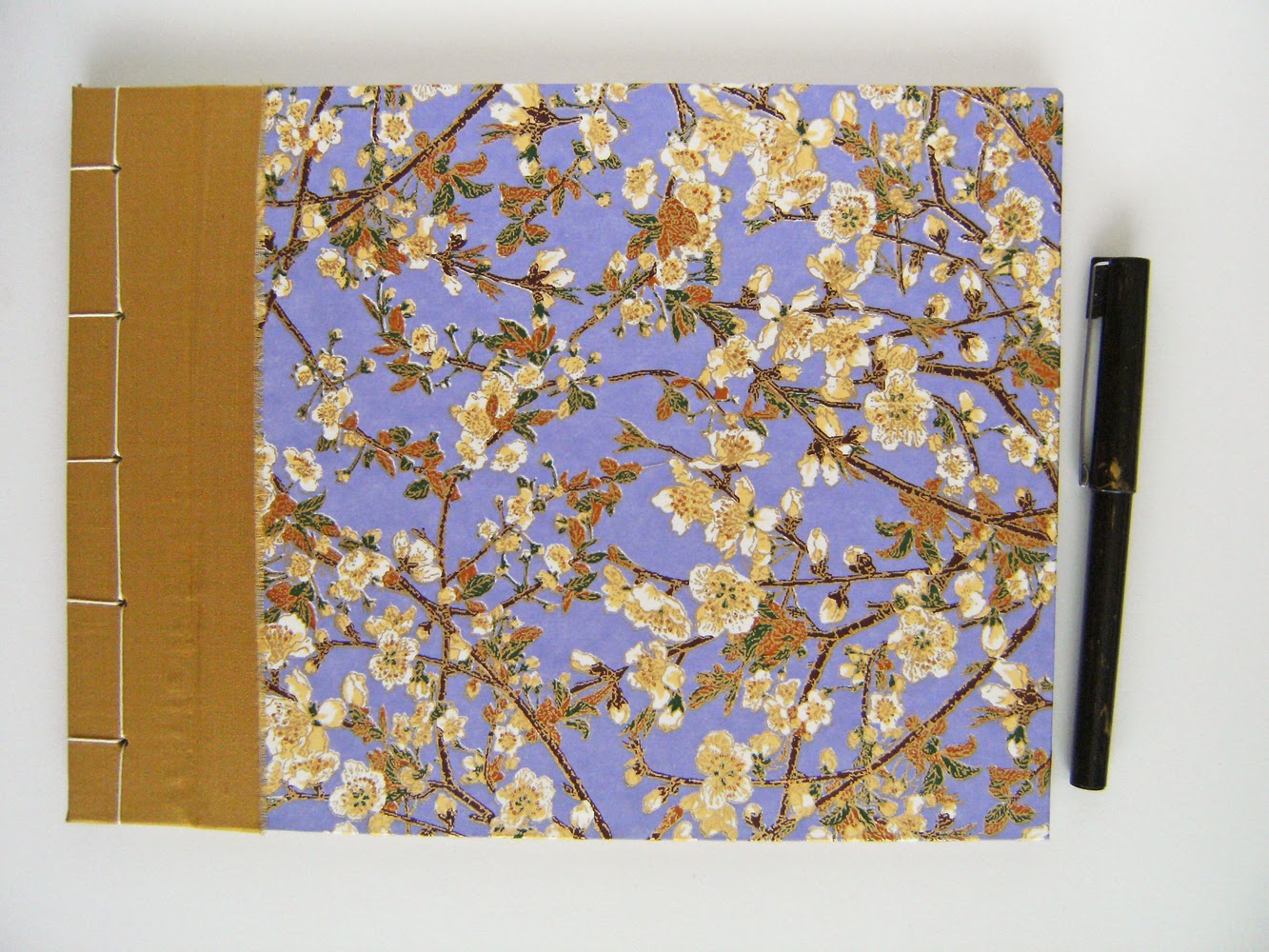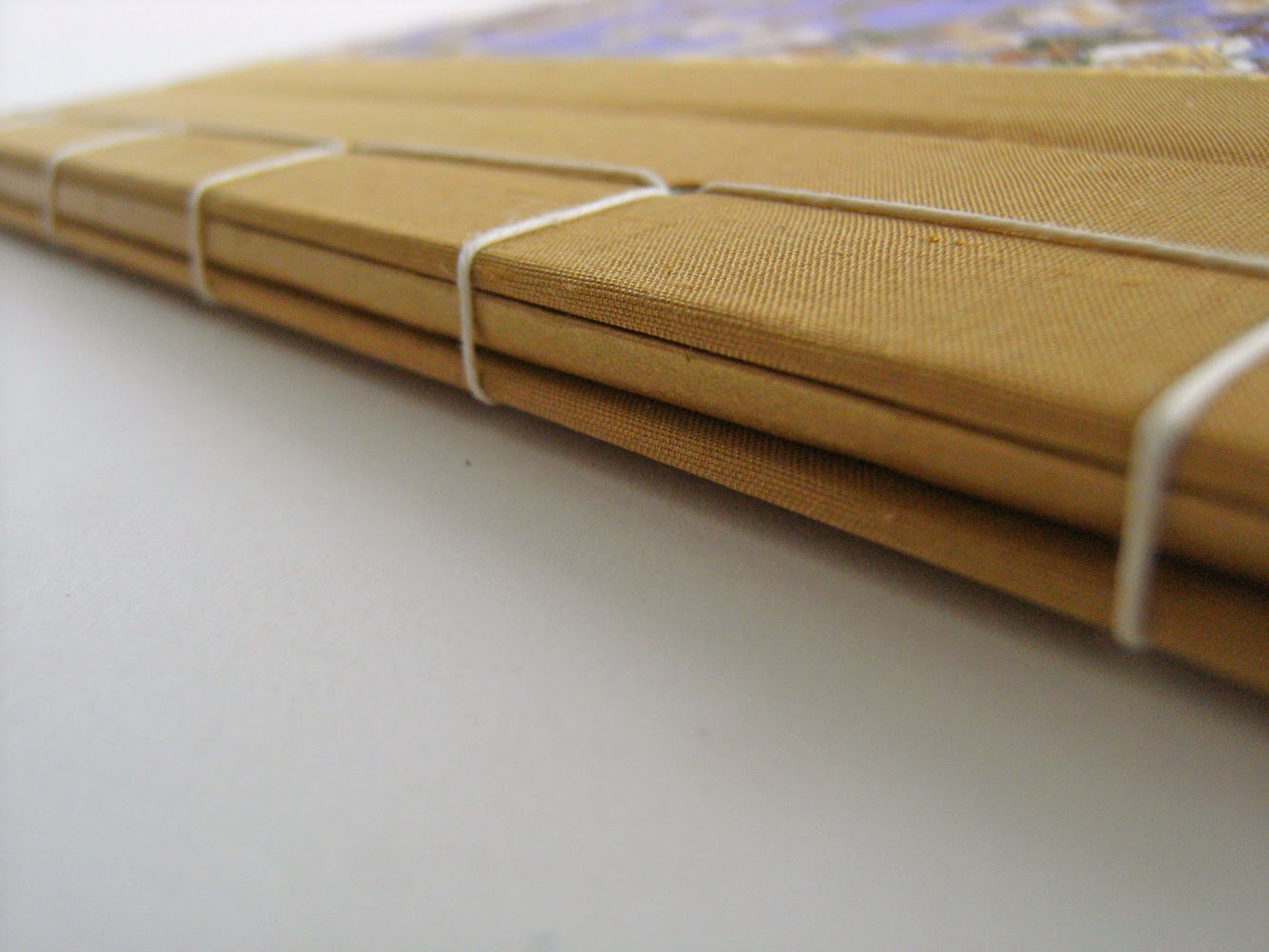Well, they say there is "nothing new under the sun" and this is certainly true of the very old craft of book-binding. However, many things are "new to me" and this week, I have been experimenting. I wanted to show you the result of an interesting experiment, which James has dubbed "Engineering with Paper and String".
* * *
I have a number of "favourite" bookbinding books, including this great book by Esther K. Smith, of Purgatory Pie Press:
"How to Make Books, by Esther K. Smith"

An Oriental-style Stab Stitch bookbinding (by LizzieMade Hand Bound Books - yours truly!)
You may notice that the cover of the book in the photos above has a hinge, to enable it to be folded back. The original stab-stitch books were made with soft papers, so the covers and pages were easily folded open; however the paper is still held firmly on the left-hand edge, so no stab-stitch book of this kind would ever open out flat.
A stab-stitch book, showing the hinged cover and how the pages are held together by their edges, so the book will not open out flat.
For the original books that were made in this way, the style of binding was not a problem, because of the materials used and the way in which the book was used also. Most were soft cover books and ledgers, with the book often being written in a vertical / portrait plane, rather than our own traditional horizontal / landscape setup. The stitching was done close to the edge, to maximise the page area and make it easier to turn the pages (this article explains the various techniques very well).
Also, when used for something like a guest book or photo album, a stab-stitch binding is very attractive and, so long as the covers are hinged and will fold back, the fact that the book will not open flat and may have to be held open for writing or viewing, is not generally a big problem. Spacers can be added between the pages and creases can be made to enable the pages to fold easily. For someone who dislikes this style of binding, there are plenty of other attractive bindings, which will allow the book to lie flat on the table or lap.
However, Esther Smith had found an old book that was a bit different to the Oriental-style bindings. The stitching was not made over the top and bottom corners of the book. It was also stitched in such a way that the thread was quite slack and would allow the pages to be manipulated so that the book would open flat.
She found that this type of binding was used for a famous Art and Design magazine, from Holland, called "Wendingen" (Pub. 1918-1932), as well as the book she had found (in a second-hand bookshop). She gives instructions to make a simple, soft-cover version of this binding, in a similar style to the book she bought; there is an illustration of a version that is similar to the Wendingen binding.
I looked online and found some photos of copies of Wendingen, so I could have a look at the binding and try to understand it. I wanted to try a version of my own, stitching single sheets into hard covers, in such a way that the album would open flat.
This is the result:
You can see that the stitching is quite loose.
Like the Wendingen Magazine, the binding is made through three pairs of holes, with stitching crossed over the spine.


The back cover - I have left the knot showing, since tucking it into the holes would not be effective anyway - it would only work its way out again, with the movement of the binding. I'm considering whether to apply a spot of glue to the knot, to prevent it coming undone, then trimming the loose ends closer to the knot. I don't think, however, that the knot looks particularly untidy - it's part of the stitching and a functional part of the binding. I like it.

The slack stitching allows the pages to be opened and turned. The book covers need to be slightly closed each time, in order for this to work...
I'm quite pleased with this book, though the binding style is very unusual. I think someone may wish to buy it, as it's an attractive and interesting book. I love the cover paper - I chose the dark green, hand made paper for the edge of the covers, as it contrasted so well with the ferns on the decorative paper and added to the jungly, exotic effect. I chose a pale grey-pink hemp cord to make the binding - it's strong, but attractive and picks out the pink shades in some of the designs on the patterned paper.
Overall, a successful Experiment, I think!
Overall, a successful Experiment, I think!










